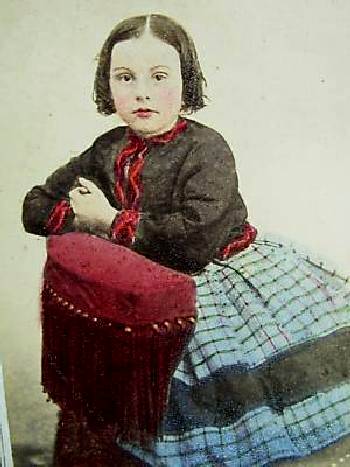
Color in Fashion: Chronological Trends

Figure 1.--Colorized images provide some clues as to color in the era of black-and-white photography. Of course the question arises as to the accuracy of the depictions. This American CDV was taken in the 1860s. The girl was from an: Poughkeepsie , New York. We believe the color depictions here are reasonable.
|
|
Color is important in the animal world, but more for birds and insects than mamals. An exception here is primates. Color acuity seems to have been an important element in the evolution of primates. And this is especially the case of humans. The human eye can recognize an amazing number of color hues. This and the fact that we know that color was important to known primative people suggests that from the earliest points of pre-history, color has been important. Initially it seems to have been connected with food recognition and acquisition, but as human society developed, color was used in fashion and decoration. Paintings provide a very useful depiction of the use of color in fashion. Here we have to realize that paintings are not color photographs. As a result, we can not be sure just how color depictions are in paintings. We note quite a few medieval paintings, for example, where crods of people are painted with extrodinarily colorful garments--almost cartoonish. We see this in both Bilical scences (often done with comtemprary clothing) and secular contemprary scenes. We think that individual portraits are more likely to have accurate color depiction. We think that by the 16th century we begin to get more accurate color depictions. Of course a great deal of art was commissioined by the Church or the aristocracy and other wealthy individuals. Thus we know much more about the elite than the common people. We note both plain brown clothes in the 18th century as well as very colorful clothes. This can be seen in the individual 18th century portraits we have found. The development of photography in the 19th century brought us much more detailed information on clothing than ever before. Unfortunately almost all photographs in the second half of the 19th century and first half of the 20th century were black and white images. Interestingly this was roughly contemporary with the beginning of the Victorian era when blaxk clothing, especially for men, was very common. Colorized images, paintings, catalogs, and magazines provide some color images. After World War II color photography becomes increasingly common, especially by the 1970s.
Physiology
Color is important in the animal world, but more for birds and insects than mamals. An exception here is primates. Color acuity seems to have been an important element in the evolution of primates. And this is especially the case of humans. The human eye can recognize an amazing number of color hues.
Pre-history
The basic phsiology of color and the fact that we know that color was important to known primative people suggests that from the earliest points of pre-history, color has been important. Initially it seems to have been connected with food recognition and acquisition, but as human society developed, color was used in fashion and decoration.
Ancient Civilizations
Medieval Era
Paintings provide a very useful depiction of the use of color in fashion. Here we have to realize that paintings are not color photographs. As a result, we can not be sure just how color depictions are in paintings. We note quite a few medieval paintings, for example, where crods of people are painted with extrodinarily colorful garments--almost cartoonish. We see this in both Bilical scences (often done with comtemprary clothing) and secular contemprary scenes. We think that individual portraits are more likely to have accurate color depiction.
Much more information omn color becomes available in the modern era. At first the major source of information was still paintings. We think that by the 16th century we begin to get more accurate color depictions. Of course a great deal of art was commissioined by the Church or the aristocracy and other wealthy individuals. Thus we know much more about the elite than the common people. We note both plain brown clothes in the 18th century as well as very colorful clothes. This can be seen in the individual 18th century portraits we have found. The sources of information on color become much more extensive and diverse in yhe 19th century. The development of photography in the 19th century brought us much more detailed information on clothing than ever before. Unfortunately almost all photographs in the second half of the 19th century and first half of the 20th century were black and white images. Interestingly this was roughly contemporary with the beginning of the Victorian era when blaxk clothing, especially for men, was very common. Colorized mostly tinted images, paintings, catalogs, and magazines provide some color images. The accuracy of color depictions varied. After World War II color photography becomes increasingly common, especially by the 1970s.
HBC

Navigate the Boys' Historical Clothing Web Site:
[Return to the Main color page]
[Introduction]
[Activities]
[Art]
[Biographies]
[Chronology]
[Clothing styles]
[Photography]
[Bibliographies]
[Contributions]
[FAQs]
[Glossary]
[Images]
[Links]
[Registration]
[Tools]
[Boys' Clothing Home]
Created: 2:47 PM 8/11/2008
Last updated: 9:34 AM 8/21/2008



